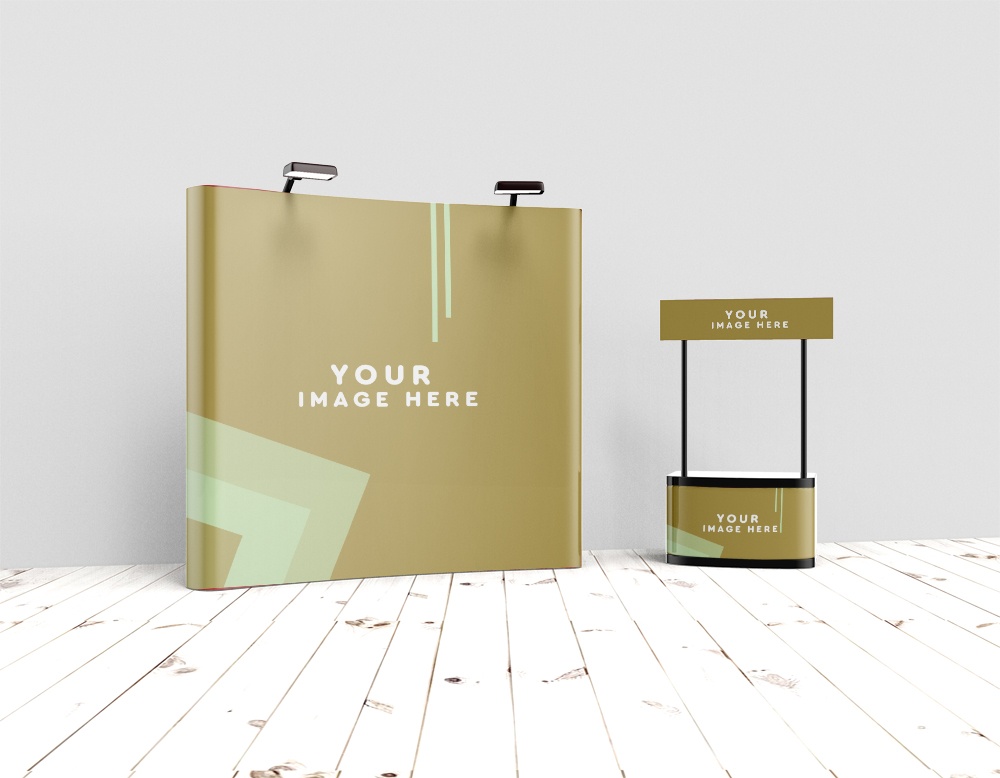Are you ready to take your trade show presence to the next level effortlessly?
Explore the realm of trade show supplies, where every booth display, backdrop, and portable tent can make a significant impact on your success.
From design and printing services to custom displays and essential items, the world of trade shows is vast and full of possibilities waiting to be unlocked.
Dive into this guide to discover how a well-equipped trade show arsenal can set you apart from the competition and elevate your brand’s visibility and appeal.
 Essential Trade Show Items
Essential Trade Show Items
Considering your trade show needs, it’s essential to be well-prepared with the right set of essential items that can make a significant difference in your exhibition experience.
Make sure to have a box cutter for various tasks and extra business cards for potential leads. Keep pens, pencils, a stapler with staples, and markers handy for organization and creative solutions.
Personal comfort essentials like mints, safety pins, a detergent pen, extra shirts, and hand sanitizer can enhance your experience. Be prepared for unexpected situations with superglue, a dolly if not provided by the venue, extra phone chargers, a business card display or holder, and name tags for effective networking.
Subscribing to newsletters can keep you updated on industry trends, event marketing tips, cost-saving strategies, and the latest in trade show displays and branding solutions. Stay ahead with expert insights on email marketing and influencer collaborations.
Booth Displays and Backdrops
When setting up your trade show booth, selecting the right booth displays and backdrops is crucial for attracting visitors and leaving a lasting impression.
Opting for innovative options like Step & Repeat, Stretch-Fabric, Illuminated, SEG, or Metal and Fabric Display Panels can elevate your booth’s visual appeal.
Step & Repeat backdrops offer branding opportunities with repeated logos, perfect for photo opportunities.
Stretch-Fabric displays provide sleek, seamless visuals that are easy to set up.
Illuminated backdrops create a captivating ambiance, drawing attention to your booth.
SEG displays offer a modern look with silicone edge graphics for a polished finish.
Metal and Fabric Display Panels combine durability with customization options, allowing for a unique booth setup tailored to your brand.
One-Click Booth Solutions
Looking to streamline your trade show booth setup effortlessly? One-Click Booth Solutions offer hand-picked assortments of complementary trade show furniture and displays, simplifying the process of creating an impactful booth. These solutions provide curated collections that include everything from furniture to displays, ensuring a cohesive and professional look for your exhibit. By opting for a one-click solution, you can save time and effort that would otherwise be spent on individually selecting and coordinating various booth elements.
These pre-packaged solutions are designed to meet the needs of exhibitors looking for a convenient and efficient way to set up their trade show booths. With a focus on ease of use and visual appeal, one-click booth solutions can help you create a standout booth that attracts visitors and effectively showcases your products or services. Take advantage of these innovative offerings to make your next trade show experience a breeze.
Portable Tents
Portable tents provide versatile solutions for both indoor and outdoor trade show events. These tents offer a convenient way to create a branded space that stands out amidst the crowd. With options for custom printing, you can showcase your logo, products, or message effectively. The flexibility of portable tents allows for easy setup and takedown, making them ideal for frequent exhibitors or those needing a quick assembly solution.
When selecting a portable tent, consider factors like size, material durability, and ease of transport. Look for features such as lightweight yet sturdy frames, weather-resistant fabrics, and innovative designs that maximize visibility. Some tents even come with added functionalities like adjustable heights, sidewalls for privacy, or integrated lighting options for enhanced visibility during evening events.
Whether you’re looking to create a comfortable indoor booth or a striking outdoor presence, portable tents offer a practical and eye-catching solution for your trade show needs. Explore the latest trends and design options to elevate your event presence and leave a lasting impression on attendees.
Design and Printing Services
For optimal trade show booth design and printing services, consider utilizing our comprehensive online designer tool to bring your creative ideas to life effortlessly. Our user-friendly drag-and-drop interface allows you to visualize and customize your trade show booth backdrop with ease. With full 3D previews available for select products, you can ensure that every detail meets your standards before finalizing your design.
Whether you’re looking for a sleek Step & Repeat display, a vibrant Stretch-Fabric backdrop, or an eye-catching Illuminated stand, our design and printing services offer a range of options to suit your needs. The online designer tool simplifies the customization process, giving you the flexibility to experiment with different layouts, colors, and graphics until you achieve the perfect look for your brand.
Experience the convenience and creativity of our design and printing services today to set your trade show booth apart from the competition.
Rental and Purchase Options
When considering trade show supplies, explore the diverse rental and purchase options available to suit your specific needs and budget. Opting for rental solutions can provide flexibility without the commitment of ownership. You can choose from modular custom printed trade show displays that are delivered to your location, shop for booths, counters, and furniture that support sustainability initiatives, and select items based on your budget and timeline requirements.
On the other hand, purchasing trade show supplies offers a long-term investment in your exhibiting assets. You can find a range of high-quality booths, displays, and accessories to elevate your presence at events. Whether you prefer the convenience of rentals or the permanence of purchases, there are options tailored to your preferences. Make informed decisions based on your exhibition goals and financial considerations to create impactful displays that resonate with your audience and drive success at trade shows.
Booth Setups
For successful trade show presentations, meticulous attention to booth setups is imperative in capturing audience engagement and showcasing your brand effectively. When setting up your booth, consider utilizing innovative booth displays and backdrops such as Step & Repeat, Stretch-Fabric, Illuminated, SEG, or Metal and Fabric Display Panels to create a visually appealing space that attracts attention. One-click booth solutions offer hand-picked assortments of complementary trade show furniture and displays for a cohesive look without the hassle of selecting individual pieces.
Portable tents with custom printing options are ideal for both indoor and outdoor events, providing a branded space that stands out. Design and printing services can bring your ideas to life with user-friendly tools and full 3D previews, ensuring your booth backdrop is precisely as envisioned. Additionally, explore rental and purchase options for modular custom printed trade show displays that support sustainability initiatives and cater to various budget and timeline needs.
Choose a booth setup like the Freedom Scientific 3 booth setup or the Make Up Forever Booth with SEG Graphic Wall for a quick and easy way to make a lasting impression.
Custom Displays
With our expertise in custom displays, we offer a diverse range of innovative solutions tailored to elevate your trade show presence. Our custom displays are designed to make a lasting impression, with attention to detail that ensures your booth stands out from the competition. From lightweight aluminum iPad and Microsoft Surface Stands to options for backlighting, we provide unlimited ideas to bring your vision to life.
Through free 1-on-1 consultations, we work closely with you to understand your brand and objectives, crafting displays that reflect your unique identity. Whether you’re looking for a sleek and modern design or something more interactive, our team is dedicated to delivering exceptional quality and service. Small touches can make a big impact, and we take pride in ensuring that every aspect of your custom display is carefully considered for maximum effect. Elevate your trade show experience with our customizable solutions that will leave a lasting impression on your audience.
Financing and Resources
When considering financing and resources for your trade show needs, it’s crucial to have access to a variety of options that cater to your specific requirements. Whether you require quick and easy financing or a comprehensive catalog of trade show solutions, Trade Show Emporium offers a range of resources to support your endeavors.
With financing approval in less than 30 seconds, you can swiftly secure the necessary equipment for your upcoming events. By accessing the Trade Show Emporium Catalog, you unlock hundreds of innovative trade show solutions tailored to enhance your exhibition experience.
Furthermore, subscribing to the newsletter provides you with special savings, keeping you informed about the latest offerings and cost-effective strategies. By offering a variety of financing options for equipment purchases, Trade Show Emporium ensures that you can acquire the tools you need without unnecessary financial strain. Explore the diverse resources available and elevate your trade show presence with ease.

